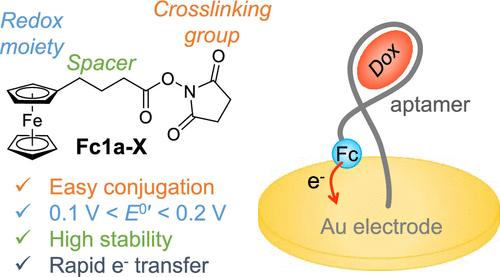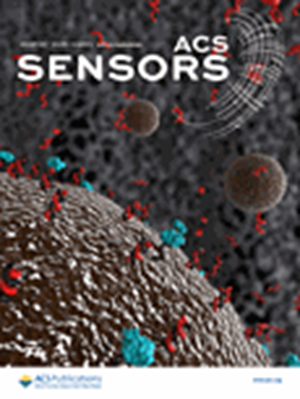二茂铁基化合物作为鲁棒和通用电化学适体传感器的替代氧化还原标记
IF 9.1
1区 化学
Q1 CHEMISTRY, ANALYTICAL
引用次数: 0
摘要
本研究探索了7种具有交联基团的二茂铁基(Fc)化合物作为亚甲基蓝(MB)的电化学适配体(E-AB)传感器的替代氧化还原标记的潜力。对这些化合物的交联效率、形式电位(E0′)和电化学耐久性进行了评价。化合物Fc1a-X表现出优异的性能,其特点是有效的交联,中等且ph不敏感的E0 ',并且在重复电位扫描期间增强了耐久性。在Au电极上,含有3碳链间隔剂和n -羟基琥珀酰亚胺-酯交联基团的Fc1a-X与胺端单分子膜的连接显示出很高的交联效率,这是实现高灵敏度的关键。适配体单层上Fc1a-X的E0′为0.14 V,在- 0.2 ~ 0.2 V /Ag /AgCl的最佳范围内。方波伏安法表明,Fc1a-X的峰值电位和电流对ph值不敏感,这对于多功能使用至关重要。在血清中,Fc1a-X保持稳定的峰值电流水平,在最初的2小时内快速下降,而不是逐渐下降,与MB相比,12小时后的下降幅度要小得多。使用Fc1a-X作为氧化还原标记,E-AB传感器有效地检测了血清中的阿霉素,覆盖了临床范围。这些发现表明Fc1a-X是开发健壮、通用和敏感的E-AB传感器的有希望的候选者。本文章由计算机程序翻译,如有差异,请以英文原文为准。

Ferrocenyl Compounds as Alternative Redox Labels for Robust and Versatile Electrochemical Aptamer-Based Sensors
This study explores the potential of seven ferrocenyl (Fc) compounds with cross-linking groups as alternative redox labels to methylene blue (MB) for electrochemical aptamer-based (E-AB) sensors. The cross-linking efficiency, formal potential (E0′), and electrochemical durability of these compounds were evaluated. Compound Fc1a-X exhibited superior performance, characterized by efficient cross-linking, a moderate and pH-insensitive E0′, and enhanced durability during repeated potential scans. The attachment of Fc1a-X, which includes a 3-carbon chain spacer and an N-hydroxysuccinimide-ester cross-linking group, to an amine-terminated monolayer on a Au electrode demonstrated high cross-linking efficiency, which is critical for achieving high sensitivity. The E0′ of Fc1a-X attached to the aptamer monolayer was 0.14 V, which is within the optimal range of −0.2 to 0.2 V vs Ag/AgCl. Square wave voltammetry showed that the peak potential and current of Fc1a-X are pH-insensitive, which is critical for versatile use. In serum, Fc1a-X maintained stable peak current levels without a gradual decrease after an initial rapid decrease during the first 2 h with considerably less reduction over 12 h compared to MB. Using Fc1a-X as the redox label, an E-AB sensor effectively detected doxorubicin in serum, covering the clinical range. These findings suggest Fc1a-X as a promising candidate for developing robust, versatile, and sensitive E-AB sensors.
求助全文
通过发布文献求助,成功后即可免费获取论文全文。
去求助
来源期刊

ACS Sensors
Chemical Engineering-Bioengineering
CiteScore
14.50
自引率
3.40%
发文量
372
期刊介绍:
ACS Sensors is a peer-reviewed research journal that focuses on the dissemination of new and original knowledge in the field of sensor science, particularly those that selectively sense chemical or biological species or processes. The journal covers a broad range of topics, including but not limited to biosensors, chemical sensors, gas sensors, intracellular sensors, single molecule sensors, cell chips, and microfluidic devices. It aims to publish articles that address conceptual advances in sensing technology applicable to various types of analytes or application papers that report on the use of existing sensing concepts in new ways or for new analytes.
 求助内容:
求助内容: 应助结果提醒方式:
应助结果提醒方式:


